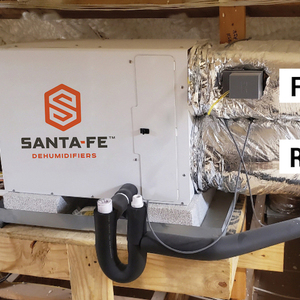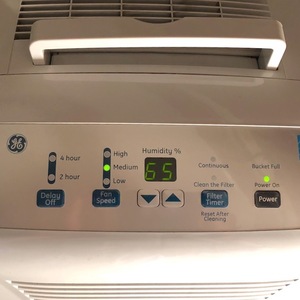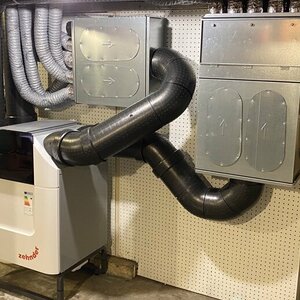
When I first sat down to write this article, I planned to show a dehumidifier doing what it’s meant to: maintain indoor humidity at a target level. I was away from home for the weekend, so I logged on to my Awair indoor air quality monitor to view a graph of relative humidity (RH) in my basement. I expected to see RH fluctuating in a tight band around 60%, dropping when the dehumidifier turned on and drifting upward when it cycled off.
To my surprise, the humidity in my basement was running at a dank 79%. Panicking a bit, I logged into Emporia energy monitor. Sure enough, the dehumidifier hadn’t drawn power for several days. With the data from the Awair and Emporia apps, I could pinpoint within about 15 minutes the moment the dehumidifier stopped running and the humidity started to rise. It was a day that I had been absent-mindedly puttering in my basement. Apparently, I had unplugged the dehumidifier and forgotten to plug it back in again.
Mechanical equipment to control indoor humidity
To maintain durable, healthy buildings, we need to manage indoor humidity. Keeping humidity at safe levels prevents the growth of asthma triggers like mold and dust mites. It can also reduce emissions of volatile organic compounds (VOCs) from building materials and extend a building’s life by slowing structural rot.
Dehumidification, along with ventilation and air conditioning, can remove moisture from the indoor air. Ventilation only works when the dew point temperature of the outdoor air is lower than that of the indoor air. These conditions occur mainly in the colder months; during the rest of the year, ventilation can bring in more moisture than it removes. A properly sized, correctly installed air conditioner (or heat pump) can also dehumidify, but it cools the house…
Weekly Newsletter
Get building science and energy efficiency advice, plus special offers, in your inbox.

This article is only available to GBA Prime Members
Sign up for a free trial and get instant access to this article as well as GBA’s complete library of premium articles and construction details.
Start Free TrialAlready a member? Log in















0 Comments
Log in or become a member to post a comment.
Sign up Log in